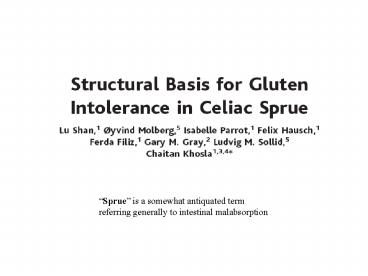Sprue is a somewhat antiquated term referring generally to intestinal malabsorption - PowerPoint PPT Presentation
1 / 24
Title:
Sprue is a somewhat antiquated term referring generally to intestinal malabsorption
Description:
Shed light on possible future treatments for celiac disease ' ... These are test results from a close family member, showing indications of celiac disease ... – PowerPoint PPT presentation
Number of Views:109
Avg rating:3.0/5.0
Title: Sprue is a somewhat antiquated term referring generally to intestinal malabsorption
1
Sprue is a somewhat antiquated term referring
generally to intestinal malabsorption
2
Celiac Disease
- One of the most common immune-mediated disorders
- Prevalence in U.S./Europe ? 1
- Implies that approx. 3M afflicted in U.S. alone
- Causes destruction of villous structure in the
intestine - Symptoms diarrhea, fatigue, abdominal pain,
malabsorption, neurological abnormalities
3
Celiac Disease
Celiac Sprue is a lifelong disease, and if
untreated it is associated with increased
mortality
4
Celiac Disease
- Triggered by ingestion of wheat gluten.
5
Gluten
- Gluten is a general term for a composite of the
storage proteins gliadin and glutenin. - These proteins (conjoined with starch) comprise
80 of the total protein in wheat/rye/barley
seed.
6
How does gluten cause negative effects?
- Certain Pro- and Gln-rich gliadin peptide
fragments survive the digestion process make it
to the gut - These peptides are deamidated by tissue
transglutaminase (tTGase) - APCs in HLA-DQ2 or DQ8 positive individuals
express these deamidated peptide fragments on
class II MHC molecules - The resulting CD4 T-cell mediated immune
response can eventually result in the development
of celiac disease
7
(No Transcript)
8
- Therefore, the only currently recognized
treatment for celiac disease is complete
abstinence from food grains containing gluten
proteins - Bread, beer, cereals, many sauces
I tried a gluten-free diet for a month this year
Lets just say that I wasnt the nicest guy to be
around during that month. Its difficult!
9
(No Transcript)
10
Aims of this study
- Determine the physiologically stable regions of
gliadin - Investigate the biochemical basis of this
stability - Shed light on possible future treatments for
celiac disease
11
Fig 1. gliadin digested with gastric
pancreatic proteases (pepsin, trypsin,
chymotrypsin, elastase, caboxypeptidase) followed
by LC-ESIMS
33-mer LQLQPFPQPQLPYPQPQLPYPQPQLPYPQPQPF
12
Significance of 33-mer
- Even after prolonged exposure to proteases, the
33-mer reamains intact - Three previously identified epitopes (PFPQPQLPY,
PQPQLPYPQ, and PYPQPQLPY) are found within this
33-mer
33-mer LQLQPFPQPQLPYPQPQLPYPQPQLPYPQPQPF
13
WQIPEQSR fragment used as a control
14
Fig. 2. BBM digestions (A) 33-mer (B) Epitope
within 33-mer
BBM brush border intestinal membrane enzymes ?
essential for breaking down any remaining
peptides after gastric and pancreatic digestion
15
Fig. 2.
33-mer LQLQPFPQPQLPYPQPQLPYPQPQLPYPQPQPF
Epitope within 33-mer QLQPFPQPQLPY
16
Implication ? theres something about the 33-mer
which makes it highly resistant to physiological
enzymatic degradation
17
Fig 3. Stimulation of 3 HLA DQ2-restricted T
cell clones, derived from patients with celiac
disease. Each of these T cell clones recognizes
a class II MHC molecule presenting a distinct
deamidated gluten epitope.
Implication ? the 33-mer is a very potent
stimulator of these HLA DQ2 restricted T cell
clones, even more so than the epitopes by
themselves Why??
EC50 80 nM (EC50 ? median effective
concentration)
18
Table 2. Respose of polyclonal T cell lines
derived from patients with celiac disease to
gluten epitopes (peptide X) and the 33-mer
(bottom row)
we interpret the combination of metabolic
stability and multivalency of the 33-mer to
endow it with exceptional toxic potency
19
Why is the 33-mer so resistant to
gastrointestinal breakdown?
- This is likely due to the abundance and location
of proline residues - This gave the authors the bright idea to
investigate the activity of a prolyl
endopeptidase (PEP) on breakdown of the 33-mer - (prolyl endopeptidases cleave peptides after
proline residues)
20
- Fig 4.
- 33-mer incubated in vitro with PEP
- 33-mer digested in vivo in rat intestine with and
without PEP - Stimulation of HLA DQ2 restricted T cell clone by
33-mer after PEP and BBM treatment, followed by
tTGase treatment
PEP seems to effectively catalyze breakdown of
the 33-mer
21
Overall implications of this study
- The 33-mer peptide, derived from gliadin, shows
several characteristics suggesting that it is the
primary initiator of the autoimmune response to
gluten in patients with celiac disease. - Potential for much further study vaccine??
- Prolyl endopeptidase therapy may have the
potential to detoxify gluten in celiac disease
patients.
22
X-ray crystal structure of 33-mer bound to HLA-DQ2
Kim, et al. PNAS (2005)
23
These are test results from a close family
member, showing indications of celiac disease
24
Questions?































